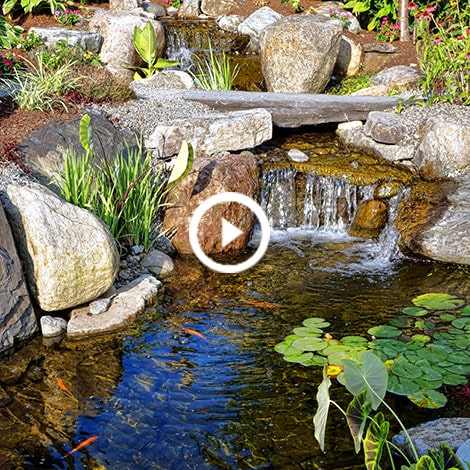A clean backyard pond doesn't just happen—you create and maintain it. Imagine seeing your fish thrive, your plants flourish, and your water turn crystal clear! You can achieve this perfect pond by understanding the five elements of a balanced aquatic ecosystem.
The Pond Guy is here to show you the ropes so you can be the best pond steward possible. Pond balance is achieved and maintained through the following elements: filtration, aeration, aquatic plants, fish, and beneficial bacteria.
Filtration Keeps Water Clean & Clear
There are two types of filtration: mechanical and biological. Mechanical filtration removes visible solids like leaves, floating debris, and fish waste using skimmers, filter brushes, and foam pads. Biological filtration eliminates microscopic waste like excess nutrients by introducing aerobic bacteria, which consume these suspended pollutants.
Aeration Adds Essential Oxygen
Waterfalls and fountain sprays alone don’t provide enough oxygen in most water gardens. To keep fish happy and healthy, add a subsurface aeration kit like the The Pond Guy Pond Aerator. Subsurface diffused aeration circulates water and increases dissolved oxygen levels. Aeration is also ideal for opening a gas exchange hole in the ice in freezing climates, keeping your fish safe from toxic gas buildup.
Aquatic Plants Control Algae
Aquatic plants are crucial to a balanced pond ecosystem. Fish waste can build up in the water and become toxic to aquatic life. Plus, many of the compounds in fish waste break down and become fertilizer that fuels rampant algal overgrowth. Pond plants like lilies outcompete algae by feeding on these same nutrients and blocking sunlight from reaching the water where algae are present. Approximately 40 – 60% of your pond's surface area should be covered in plants, especially if it is in direct sunlight most of the day.
Fish Bring Garden Ponds to Life
Pond fish add color, movement, and visual interest to your aquascape, plus they make great pets. Koi are smart, friendly, and enjoy the bonding experience that hand feeding offers. As fish multiply and grow, they add more waste that must be controlled by a filtration system sized to handle your fish population. As a general rule, in koi ponds with adequate filtration and plant coverage, allow a maximum of two koi or three goldfish per 200 gallons of water.
Beneficial Bacteria Simplify Water Gardening
Natural bacteria treatments like The Pond Guy DefensePAC help keep your pond balanced between chores. The bacteria in the DefensePAC break down waste, remove excess nutrients, and maintain clear water all season.
Aquascaping the Perfect Water Garden
If you are just getting started on your water gardening journey, you likely have many questions. Our pond experts are here to help! Contact us online or call us at 866-POND-HELP for prompt and friendly advice.
Do you want to learn more about the five elements of a balanced aquatic garden? Check out the following detailed guides:
Types of Filtration
Benefits of Water Garden Aeration
Benefits of Aquatic Plants in a Water Garden
Understanding the Nitrogen Cycle
Benefits of the DefensePAC
Last Updated: May 28, 2024

